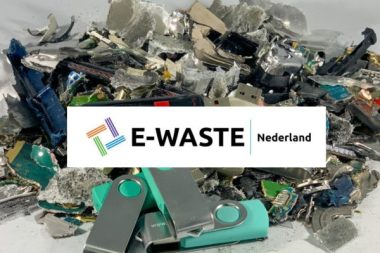How do I destroy an old USB stick?
What is the best way to destroy an old USB stick without exposing sensitive data? USB sticks destruction seems simple, but effective and safe destruction requires more than just inflicting physical damage.
In this blog you will discover which methods really work, which are unsafe, and what you should pay attention to in the areas of GDPR compliance, data security and environmental friendliness – both as a private individual and as a company.
Shredding USB stick
Physical destruction, or shredding a USB stick with an industrial data shredder, is the most effective method. This method grinds sticks into ultra-fine particles, making data unrecoverable. There is simply nothing left of the data carrier, except waste. This method is used in almost all cases by a certified IT data destruction companyIt is fully GDPR compliant and suitable for companies that want certainty about the destruction of their data.
Erase or wipe USB stick
Using certified software, such as Blancco, can erase or wipe data on a USB stick. This is also called 'overwriting'. This method is suitable if the USB stick needs to be reused. It is important for companies that the erasure is carried out by a certified party and that an official certificate of data destruction is provided .
Destroy USB stick with hammer
Physically damaging a USB stick with a hammer may damage the casing, but the memory chip often remains (partly) intact. This may allow data to be recovered. For businesses this method is insufficient and not GDPR compliant. Individuals can try this but should protect themselves well with safety glasses and gloves for flying shards.
Degaussing USB stick
Degaussing, the demagnetization of storage media, is effective for magnetic media such as hard drives. However, USB sticks use flash memory and are not sensitive to magnetic fields, making this method ineffective. So degaussing a USB stick is not possible.
USB stick buried
Burying a USB stick may seem like a creative solution, but it doesn't make much sense. The data remains on the memory chip and can be recovered even years later under all kinds of weather conditions and moisture. Furthermore, it is not legally allowed to put electronic equipment in the ground. It is bad for the environment. And besides, others can (accidentally) dig up the stick.
Destroy USB stick with water
Immersing a USB stick in water can damage electronic components, but the memory chip often remains intact. Data can still be retrieved using specialized software. For companies, this method will never be GDPR compliant.
Burn USB stick
Burning a USB stick is dangerous and inefficient. The memory chip can withstand high temperatures, which means data remains partially intact. Moreover, it is harmful to the environment and dangerous to do yourself.
USB stick in microwave
Putting a USB stick in a microwave is downright dangerous. The metal parts can cause sparks, which can lead to a short circuit or even fire. Furthermore, microwaves do not reliably destroy data.
Return USB stick to recycling center
Returning a USB stick to the recycling center is a first step towards sustainable waste processing, but no guarantee of data destruction. Recycling centers recycle devices, but do not erase or destroy data. This means that data may end up on the street or at a thrift store.
Destroy USB stick with magnet
Using a magnet to destroy a USB stick is ineffective. USB sticks use flash memory, which is not sensitive to magnetic fields. This method does not guarantee that data will be irretrievably deleted.
Throw away USB stick
Throwing a USB stick in the trash is very unwise. The data remains intact and can easily be read by third parties. For companies, this is in conflict with the GDPR, and private individuals are also at risk of identity fraud.
Destroy USB stick with drill
Drilling the USB stick, especially the memory chip, can be more effective than using a hammer. Drilling multiple holes increases the chance of data loss. But it is also a dangerous job, because a USB stick is small and difficult to handle. It is advisable to first secure the stick with a clamp and then drill through.

Throwing away USB stick? First delete all data!
Simply throwing away a USB stick without first deleting the data is a big risk. Even if you have manually deleted files or formatted the stick, the data is often easily recoverable with free software. This applies to both personal documents and sensitive company information.
If you really want to throw away the USB stick, first ensure thorough data erasure. Use certified erasure software or have the stick professionally erased or destroyed by an IT data destruction company. This is the only way to be sure that no one will gain access to your old data.
What should companies pay attention to when destroying USB sticks?
Look out for important certifications such as WEEELABEX, ISO 9001, ISO 14001, ISO 27001 and Blancco.
Choose a data destruction company with experience in the business market.
Ask for a clear and transparent cost structure.
Check if an official certificate of destruction is provided.
Ensure that the method is GDPR compliant and suitable for audits.
Conclusion: What is the safest method to destroy a USB stick?
The safest method to destroy a USB stick is certified physical destruction (shredding) or professional software erasure.
Homeowners can try some other methods (such as drilling or smashing with a hammer), but they always take a risk. Companies are legally obliged to provide security. Opt for a GDPR-compliant approach, including collection, reporting and certificate of destruction of all types of USB sticks, flash drives and memory cards.
As a company, do you want to be sure that your USB stick has really been destroyed? Request a no-obligation quote now.
(E-Waste Nederland works exclusively for companies, not for private individuals)
